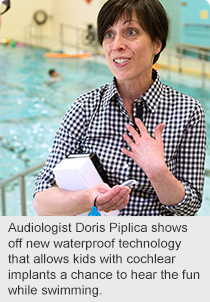
June 12, 2014
Story by Gregory Kennedy; Photo by Amber Bracken
EDMONTON — In the hands of nine-year-old Keegan Dos Santos, the long foam noodle slams down like thunder, sending waves and echoes off the rafters over the pool at Glenrose Rehabilitation Hospital.
Nearby, new friends Cayden Mazurak, 6, and his sister Michaela, 8, splash away with a beach ball.
For some, their happy shouts are just noise — maybe too much of it — but for the families and audiologists here, the decibels add up to a beautiful, heavenly din.
In the past, children such as Keegan and Cayden — who both have cochlear implants — couldn’t hear any of the fun, let alone share it so easily with one another.
But now, as summer fun arrives, kids with cochlear implants no longer have to choose between making a splash in silence and hearing the fun from the sidelines thanks to new waterproof technology available through the Cochlear Implant Service at the Glenrose, and also at the Alberta Children’s Hospital and the Richmond Road Diagnostic and Treatment Centre in Calgary.
The implants have been around since the 1970s but only now can people with hearing loss swim in and under water with confidence while wearing these electronic devices.
The implants are comprised of two parts: a device that a surgeon implants in the skull and ear, and external equipment that’s worn on and above the ear. Together they provide a sense of sound to people who are profoundly deaf or severely hard of hearing because of damage to the sensory hair cells in their cochleas, the auditory portion of the inner ear.
With new waterproof designs, sleeves and rubberized components, keeping the electronics dry is no longer a nagging concern for watersports enthusiasts of all ages who wish to hear the action as they dive in the deep end, snorkel in the ocean, train for a triathlon or even surf the half-pipe.
“Part of being in the water is the communication that happens in the water,” says Alberta Health Services (AHS) audiologist Doris Piplica.
“It’s not just about splashing around; it’s about the conversations that happen, the talking and the playing. It’s very isolating for a child who normally hears to not be able to hear.
“One child I follow told me he dreads the year-end school water park party. He can’t function like he normally functions, because he has to take off his hearing device and miss out on all the fun. So, unlike his classmates who look forward to the party, this very social kid actually dreads it.”
Kids in swim class will now be able to hear, rather than struggle to lip-read, what their coach is saying.
Keegan, who loves the water, has been taking swimming lessons since the age of five months, says his mother Michelle of Edmonton.
“Obviously, he couldn’t hear during his swim lessons at all — because all the gadgets had to come off,” she says. “For years, he didn’t know what was going on with his friends. He couldn’t hear what they were saying back to him. Now, he can have a conversation with his friends.”
The Cochlear Implant Service — which actively follows more than 400 patients and performs 50 to 60 implants a year in the Edmonton area — will celebrate its 30th anniversary in 2016. Its team members include audiologists, surgeons, speech-language pathologists, auditory-verbal therapists, a psychologist, a social worker and a transition worker (who helps pre-school children as they enter school).
“I’ve been an audiologist for a long time,” says Piplica, “and one of the things you want for your hearing-impaired children is for them to be able to function like the other kids. The more they can be like the other kids, the happier they are.”
And judging by the whoops and hollers in the Glenrose pool, the kids are all right.